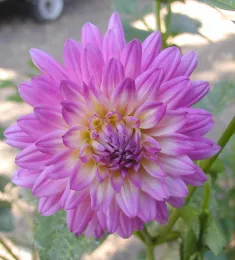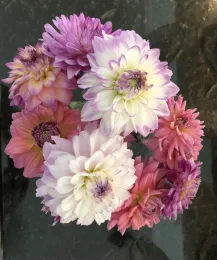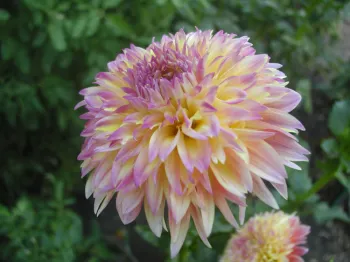
It is packed not only with gorgeous pictures from the world of Dahlias, but also with knowledge to grow these fantastic flowers. The book informs on using dahlias in garden design, in containers, growing and propagation information as well as ways to display them as a cut flower. He includes several pages of brief descriptions of flowering annuals and perennials that can be companions of Dahlias. He describes the various types and sizes of Dahlias, a somewhat confusing array of information, but a necessary and useful guide to have when ordering Dahlias from catalogues.

Being a Dahlia fancier, I had to count the number featured with the number that I have or have had in my own garden. Alas, I only had about 19 of the featured Dahlias and there were so many new beauties that I now want to acquire. I didn't need this book to know that, as the Swan Island Dahlia catalogue each winter challenges me with an awesome array of choices. Although the author does not grow lots of Dahlias, he found lots of folks to share theirs with him and his camera.
Andy Vernon explained some things to me that I didn't know about Dahlias. The reason there are so many sizes, forms and colors is due to polyploid chromosomes and the many possible resulting hybrids developed by breeders and hobbyists. Humans are diploid (2n) in chromosome pairing, but Dahlias have four times as many, being octoploid (8n). This apparently gives them lots of genetic possibilities that we are still learning about. In addition, many new cultivars are likely to be developed by plant breeders hybridizing new Dahlias from the 36 species of Dahlias found in the wild.

This makes it pretty easy for even an amateur to come up with a new Dahlia. Breeders are doing that regularly. There are over 20,000 named Dahlias, so if you planted a hundred every year it would take you 200 years to see them all and by then there would likely be another few thousands introduced. Dahlias are mutation prone, and I have seen Dahlias revert to one of their parents or something totally different from what I originally assumed I had planted. A Dahlia may have two differing flowers occurring from one tuber, apparently because of a spontaneous mutation.
- The book winds down with sections on:
- how to store tubers effectively and efficiently.
- dealing with pests, diseases, and disorders.
- information on how to hybridize Dahlias.
- avoiding the spread of viruses with unclean cutting tools.
If you are interested in Dahlias for landscaping or as a cut flower garden addition, or just want to know a lot about Dahlias, this book is a good place to start.

